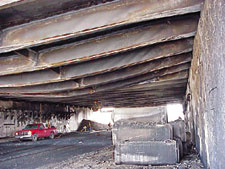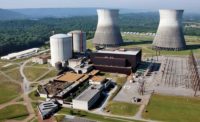 |
| BURNED Steel girders of I-95 overpass melted when burning fuel spilled to access road below. (Photo courtesy of FHWA) |
A March 25 accident on an Interstate 95 bridge in Bridgeport, Conn., resulted in a conflagration that shut the highway down for three days before swift-acting crews reopened northbound lanes, with southbound lanes expected to reopen by April 1. Many support beams of the steel bridge, which was being widened, were deformed by the fire.
The accident occurred around 7:45 p.m., when an automobile struck an 18-wheel tanker truck carrying 9,000 gallons of #2 fuel oil in the southbound lanes, say state police. The truck crashed into a Jersey barrier and the tank ruptured. "The tanker opened up and spilled product on the highway," says Michael A. Maglione, chief of the Bridgeport Fire Dept. "We think cars passing through the product created a mist that found an ignition point, which created a fireball on top of the highway." Burning oil also ran down storm drains onto a two-lane local access road and began heating the bridges steel girders. "They were glowing orange and sagging 3 ft to 4 ft," says Maglione.
 |  |
| KEAZER | MAGLIONE |
A 42-ft-wide Acrow panel temporary bridge has been ordered for the southbound span, which "looks like a complete loss," says Bradley D. Keazer, Federal Highway Administration division administrator. "Well take it out, clean the abutments and set up the temporary." Material tests were done on the charred but intact northbound girders, now bolstered with steel supports. "We still need to decide if we want to blast and paint or if we want to replace the [northbound] superstructure at a later date," he says.
The bridge is part of a five-contract, $400-million federally funded widening, involving 20 structures. "It was a simple span bridge, 72 ft long," says Keazer. "We were taking an eight-lane, 18-girder span and widening it to 26 girders and 10 lanes."
|
Crews with the local joint venture of M. DeMatteo Construction Co. and Brunalli Construction Co., doing the widening, were not on site when the fire broke out. Once all lanes are reopened, DeMatteo/Brunalli will continue demolition of the center area, complete the new segment, move the southbound lanes onto the median, remove the temporary bridge and rebuild the south lane. "It could add another stage to our construction program and cost up to $11.2 million, which includes emergency detouring and replacement," says Keazer.
DeMatteo/Brunalli is also performing the emergency work. "We have waived the competitive bid process," Keazer says. The joint venture contract was for $121 million and scheduled for a December completion, but state officials had wanted an expedited repair effort. "Any potential contract extensions will be evaluated at a later date," says Keazer.
Sixty firefighters were needed to control the fire, with hoses pumping water at 500 gallons per minute to cool the steel beams. Foam was also used on the deck. Fuel that flowed into a local stream inlet was quickly contained, says Maglione.
State and local police had to shut down I-95, which carries about 120,000 vehicles a day, and reroute traffic through the city. Only two minor injuries were reported, although Maglione estimates the blaze produced temperatures of 1,800°F.


Post a comment to this article
Report Abusive Comment